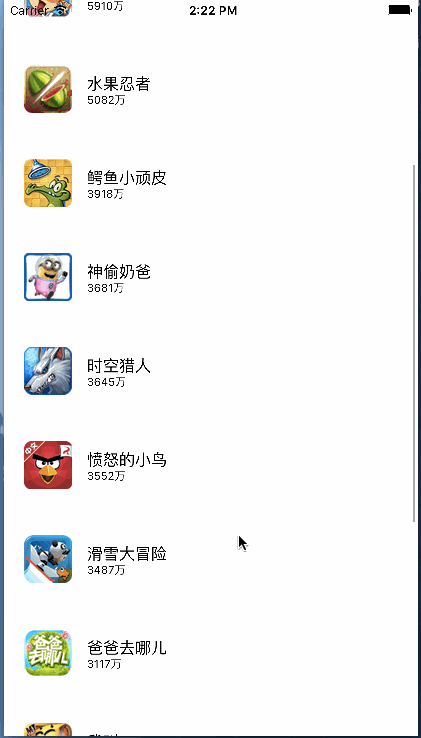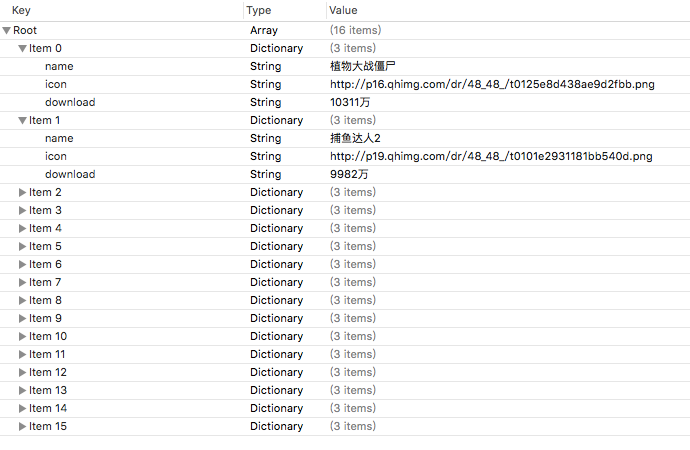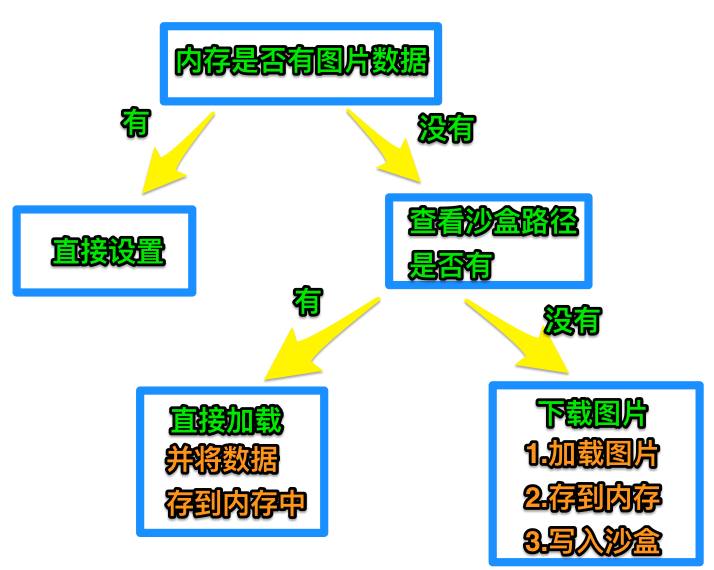
- 一个不会说话的汤姆猫游戏源码
- 利用put上传文件到服务器
- IOS封装自定义布局的方法
- IOS自动布局-UIStackPanel和UIGridPanel(五)
- UIGestureRecognizer手势操作
- IOS自动布局-UIStackPanel和UIGridPanel(一)
- ios开发-UI基础-应用管理(单纯界面)改进3-xib使用
- 瀑布流-03-通过封装的自定义布局快速实现商品展示
- swift-正则验证手机号码
- 在TableVIew中搜索筛选:谓词
- 禁用iOS9AppTransportSecurity(ATS)特性时不起作用
- iOS开发中GCD在多线程方面的理解
- [iOS基础控件-5.1]UIScrollView
- GPUImageAPI文档之GLProgram类
- iOS中nil,Nil,NULL的区别
- iOS中的导航栏UINavigationBar与工具栏UIToolBar要点解析
- java和android及IOS对接RSA加密经验
- ios各种手势,很有意思
- iOS开发——OC篇&纯代码退出键盘
- 改错总结(1)
- objc单例的两种安全实现方案
- iOS开发之ImageView复用实现图片无限轮播
- Objective-C的缓存框架EGOCache在iOS App开发中的使用
- 3D地图导航应用源码
- iOS开发中使用UIDynamic来捕捉动画组件的重力行为
- 使用Xcode为iOS应用项目创建PCH文件的方法及应用示例
- iOSUILabel自定义行间距时获取高度
- iOS加入公司开发者团队进行真机测试
- iOS应用中存储用户设置的plist文件的创建与读写教程
- [随时更新][iOS]小问题记录
IOS多线程实现多图片下载(一)
作者:佚名 IOS开发编辑:admin 更新时间:2022-07-23
在没有步入正文之前先给大家展示下效果图,如果大家觉得很满意请继续往下阅读全文。

大家可以看到这个界面很简单,其实就是UITableView的布局,但是难点是在于如何从网上下载这些图片,下载之后应如何进行存储!
我们一步一步进行解析,先从单线程(主线程)进行多图片下载我们布局上的文字及图片的地址从plist文件中进行读取

根据结构,我们自定义一个数据模型文件
DDZApp.h
#import <Foundation/Foundation.h> @interface DDZApp : NSObject //图标 @property (nonatomic,strong) NSString *icon; //名字 @property (nonatomic,strong) NSString *name; //下载量 @property (nonatomic,strong) NSString *download; + (instancetype)appWithDict:(NSDictionary *)dict; @end
DDZApp.m
#import "DDZApp.h"
@implementation DDZApp
+ (instancetype)appWithDict:(NSDictionary *)dict {
DDZApp *app = [[self alloc] init];
[app setValuesForKeysWithDictionary:dict];
return app;
}
@end
以下的都是视图控制器中的代码
ViewController.m
1.
@interface ViewController () //所有数据 @property (nonatomic,strong)NSArray *apps; //内存缓存图片 @property (nonatomic,strong)NSMutableDictionary *imgCache; @end
第一个属性用于存储读取plist文件中的内容,设置为属性保存起来,就可以不用重复读取
第二个属性用于保存从网上下载下来的图片,也是为了不用重复读取
2.
@implementation ViewController
//读取数据
- (NSArray *)apps {
if (!_apps) {
//从plist文件中读取数据
NSArray *dictArray = [NSArray arrayWithContentsOfFile:[[NSBundle mainBundle] pathForResource:@"apps.plist" ofType:nil]];
NSMutableArray *appArray = [NSMutableArray array];
for (NSDictionary *dict in dictArray) {
[appArray addObject:[DDZApp appWithDict:dict]];
}
_apps = appArray;
}
return _apps;
}
//缓存图片
- (NSMutableDictionary *)imgCache {
if (!_imgCache) {
//初始化
_imgCache = [NSMutableDictionary dictionary];
}
return _imgCache;
}
这两个方法都是为了初始化刚才的两个属性
3.
#pragma mark - 数据源方法
- (NSInteger)tableView:(UITableView *)tableView numberOfRowsInSection:(NSInteger)section {
return self.apps.count;
}
- (UITableViewCell *)tableView:(UITableView *)tableView cellForRowAtIndexPath:(NSIndexPath *)indexPath {
static NSString *ID = @"app";
UITableViewCell *cell = [tableView dequeueReusableCellWithIdentifier:ID];
DDZApp *app = self.apps[indexPath.row];
cell.textLabel.text = app.name;
cell.detailTextLabel.text = app.download;
//先从内存中取出图片
UIImage *image = self.imgCache[app.icon];
if (image) {
cell.imageView.image = image;
}else {
//内存中没有图片
//将图片文件数据写入到沙盒中
NSString *cachesPath = [NSSearchPathForDirectoriesInDomains(NSCachesDirectory, NSUserDomainMask, YES) firstObject];
//获得文件名
NSString *filename = [app.icon lastPathComponent];
//计算出文件的全路径
NSString *file = [cachesPath stringByAppendingPathComponent:filename];
//加载沙盒的文件数据
NSData *data = [NSData dataWithContentsOfFile:file];
//判断沙盒中是否有图片
if (data) {
//直接加载沙盒中图片
cell.imageView.image = [UIImage imageWithData:data];
//存到字典(内存)中
self.imgCache[app.icon] = cell.imageView.image;
}else {
//下载图片
data = [NSData dataWithContentsOfURL:[NSURL URLWithString:app.icon]];
cell.imageView.image = [UIImage imageWithData:data];
//存到内存中
self.imgCache[app.icon] = cell.imageView.image;
//将图片数据写入到沙盒中
[data writeToFile:file atomically:YES];
}
}
return cell;
}
这两个方法是UITableView必须要实现的方法
第一个是返回数据量,没什么好说的
第二个是绑定数据
具体的流程看下图

以上内容针对IOS多线程实现多图片下载(一)的相关介绍,希望对大家有所帮助,下篇文章继续给大家介绍IOS多线程实现多图片下载(二),感兴趣的朋友请持续关注。
- 上一篇文章: 改变iOS应用中UITableView的背景颜色与背景图片的方法
- 下一篇文章: IOS多线程实现多图片下载(二)
- iOS开发网络数据(AFNetWorking使用)
- 简单掌握iOS应用开发中sandbox沙盒的使用
- Objective-C可变参数的函数实现
- iOS开发中使用屏幕旋转功能的相关方法
- iOS开发中常见的解析XML的类库以及简要安装
- IOS性能调优系列:使用Zombies动态分析内存
- IOS框架Spring常用的动画效果